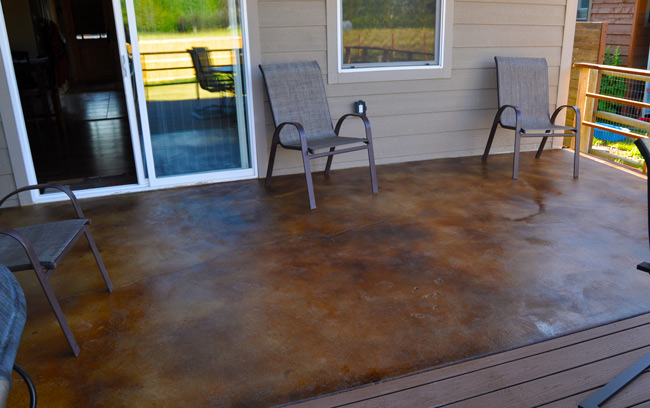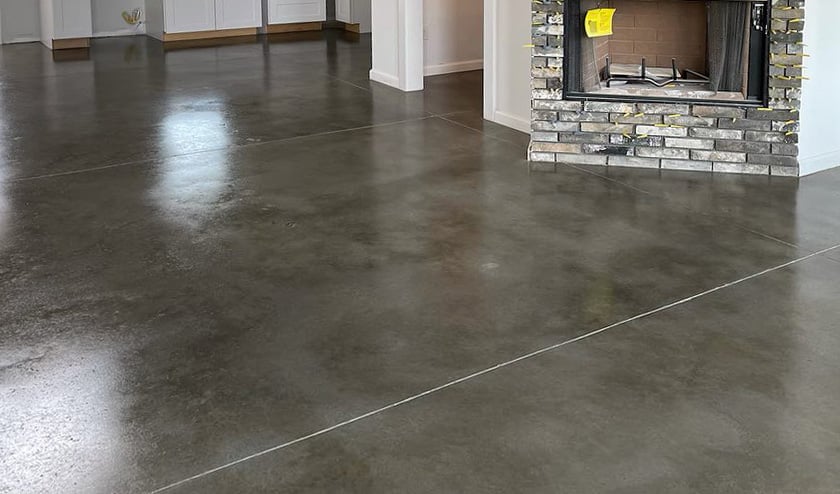Why stained concrete austin is the budget-friendly flooring solution
Wiki Article
Recognizing the Different Kinds of Stained Concrete for Your Following Project
Stained concrete deals various choices that cater to different visual and functional demands. Each type provides distinct attributes that influence the final appearance and durability of the surface area. Understanding these differences is vital for any person intending a job. From rich, chemical responses of acid-based stains to the vibrant harmony of strong color stains, the options can considerably impact the result. What factors should one think about when picking the optimal tarnish for their particular requirements?Introduction of Stained Concrete
Stained concrete functions as a versatile flooring choice that can enhance the visual allure of numerous spaces. This method entails using a tinting representative to the surface area of existing concrete, enabling a wide spectrum of design possibilities. Stained concrete is preferred in both property and commercial atmospheres, supplying a durable and low-maintenance solution that can imitate the look of natural materials like stone or ceramic tile.The staining procedure can be performed using water-based or solvent-based products, each giving distinctive visual results. The last appearance is influenced by aspects such as the initial concrete surface, the kind of tarnish used, and the application method. Stained concrete not only beautifies exterior and interiors but also promotes sustainability by rejuvenating existing concrete structures. Consequently, it has acquired traction amongst homeowners and designers seeking both functionality and design in their floor covering options.
Acid-Based Stains: Attributes and Advantages

Unique Color Variations
Concrete surfaces can transform considerably with the application of acid-based stains, which offer a rich combination of special shade variants. These stains pass through the concrete, responding chemically to generate vivid earth tones that range from deep browns and reds to soft greens and blues. The resulting shades are typically variegated, producing an all-natural, marble-like look that enhances the concrete's character. Each application yields distinct results due to variations in the concrete's composition and the staining strategy made use of, making every task one-of-a-kind. In addition, acid-based stains can be split or integrated with other methods to produce personalized styles, allowing for personal expression. This versatility makes acid-based stains a popular selection for both household and business applications.Chemical Responses Explained
While many factors add to the performance of acid-based stains, the underlying chain reaction play an important role in their unique characteristics and advantages. These stains mostly include water, acid, and metal salts. When related to concrete, the acid reacts with the calcium hydroxide in the cement, producing a chemical change that causes long-term color adjustments. The metallic salts pass through the surface and bond with the concrete, allowing for a variety of hues and tones. This response not only boosts visual charm yet likewise provides longevity, making the shade resistant to fading and wear. Furthermore, acid-based stains can produce a variegated coating that imitates all-natural stone, more improving their appeal for attractive concrete applications.Surface Preparation Value
Achieving excellent results with acid-based stains pivots on comprehensive surface preparation. This necessary step assurances that the concrete surface area is clean, without contaminants, and appropriately profiled for ideal discolor absorption. Any kind of existing sealers, dirt, or oils can prevent the chain reaction that creates the wanted color and surface, bring about uneven or irregular outcomes.Prior to using the discolor, the concrete should be mechanically cleaned up or stress cleaned, adhered to by a complete examination for cracks or flaws that may need fixing. Additionally, confirming the surface is effectively dried out will certainly boost discolor adherence. By focusing on these primary actions, the longevity and vibrancy of acid-based stains can be significantly enhanced, leading to a much more cosmetically pleasing and sturdy coating.
Water-Based Stains: Attributes and Benefits

Water-based stains pass through the concrete, using a much more transparent finish that highlights the natural appearance and variations of the surface under. They are offered in a wide variety of shades, permitting creative adaptability in style. Furthermore, water-based stains are easier to tidy up, calling for only water and soap, which streamlines the application procedure.
Their quick drying time improves effectiveness, making them a sensible choice for both do it yourself enthusiasts and experts. On the whole, water-based stains provide an appealing combination of aesthetic adaptability and easy to use homes, making them a popular alternative for concrete improvement tasks.
Strong Shade Stains: Vivid Alternatives for a Vibrant Look
Solid color stains offer an effective service for those seeking to create a bold and lively aesthetic on concrete surfaces. These stains provide a consistent pigmentation that can significantly enhance the aesthetic allure of floorings, patio areas, and driveways. Readily available in a large range of shades, solid color stains permit creative expression, accommodating various layout choices.One of the essential advantages of strong shade stains is their ability to hide blemishes, supplying a fresh and refined aim to maturing concrete - Stained Concrete Austin. Additionally, their solution normally includes UV-resistant residential properties, making sure longevity and shade retention even in harsh weather
Application is uncomplicated, needing minimal prep work of the concrete surface. As soon as applied, strong color stains can be sealed for added security and sheen, more raising their visual high quality. With their vibrant choices, solid shade stains are an exceptional choice for those going for an impactful and cohesive design.
Semi-Transparent Stains: Achieving Depth and Dimension
Semi-transparent stains offer a special method to boosting concrete surfaces by supplying deepness and measurement via different shade choices. Understanding the application methods is important for attaining the desired impact, while correct maintenance practices ensure longevity. This section will certainly check out these vital aspects to look what i found optimize the advantages of semi-transparent discoloration.Color Options Available
A wide array of shade options exists for semi-transparent stains, enabling home owners and developers to improve the natural elegance of concrete surface areas. These stains come in a range of shades, from natural tones like browns and terracottas to vibrant colors such as blues and environment-friendlies. The semi-transparent nature of these stains allows the underlying concrete to reveal through, producing a distinct depth and dimension that can complement different design aesthetics. Furthermore, integrating different shades can generate customized tones, enabling a customized search for each project. This flexibility makes semi-transparent stains a preferred selection for both exterior and interior applications, as they can balance with surrounding elements while adding aesthetic passion to ordinary concrete.Application Strategies Described
To achieve the preferred deepness and measurement with semi-transparent stains, correct application strategies are crucial. Surface preparation is vital; the concrete has to be clean and complimentary of any type of pollutants. This often involves power cleaning and fixing any cracks. Next, picking the best applicator, such as a sprayer, roller, or brush, can influence the last look. Sprayers permit a more even application, while rollers can assist accomplish appearance. It is essential to apply the discolor in slim, even layers, allowing each layer to completely dry prior to adding an additional. Manipulating the application strategy, such as varying pressure or making use of different devices, can produce unique impacts. Securing the stained surface area boosts the vibrancy of the colors while supplying protection.Upkeep Finest Practices
Normal upkeep is vital for protecting the appeal see this page and honesty of surfaces treated with semi-transparent stains. To preserve these surface areas, regular cleansing is important. Utilizing a pH-neutral cleaner and a soft-bristle mop will assist remove dust and debris without harming the discolor. It is recommended to prevent rough chemicals, as they can degrade the stain's look. Furthermore, regular resealing each to 3 years can secure against wear and fading. This process entails cleansing the surface area thoroughly and using a compatible sealant developed for stained concrete. Property owners need to additionally check for any type of indications of staining or damage and address these concerns immediately to ensure resilient vibrancy and durability. Adhering to these best practices will enhance the overall life-span of semi-transparent stained surfaces.Effects and Techniques: Personalizing Your Stained Concrete
Customizing stained concrete entails a range of strategies that boost both visual appeals and functionality. Among these methods, layering different tarnish colors can create depth and complexity, permitting distinct visual impacts. Techniques such as acid discoloration offer a variegated appearance, while water-based stains provide a much more uniform appearance.Furthermore, incorporating ornamental patterns, such as stenciling or engraving, can even more personalize the surface area, adding complex layouts that provide to individual preferences. Texturing the concrete, whether with marking or mop finishes, introduces tactile components that not just enhance hold but also improve visual rate of interest.
Using sealers can amplify the color vibrancy and provide defense against wear. Customization strategies prolong past plain shade; they can change a typical concrete piece right into a stunning centerpiece, making it appropriate for both residential and industrial areas. Through mindful choice of results and methods, stained concrete can achieve a truly tailored look.
Upkeep and Durability of Stained Surfaces
Stained concrete surface areas are known for their durability and aesthetic charm, maintaining their integrity is important for ensuring durability. Routine cleaning is essential; sweeping and wiping with a pH-neutral cleaner assists protect against dust accumulation and discoloration. Furthermore, applying a sealer every couple of years can shield the surface from dampness, chemicals, and UV damages, thus enhancing its life expectancy.It is likewise important to address any splits or chips promptly. Little fixings can minimize more degeneration, protecting the visual and architectural high quality of the surface. For outdoor stained concrete, seasonal maintenance, such as eliminating snow and ice, is necessary to stop surface area damages from freeze-thaw cycles.
Frequently Asked Questions
Can I Discolor Existing Concrete Surfaces or New Ones?
The concern of whether existing concrete surfaces can be stained emerges often. It is indeed feasible to stain both brand-new and old concrete, offered the surface area is appropriately ready and devoid of impurities for perfect adhesion.How much time Does the Staining Process Normally Take?
The staining process commonly takes one to three days, depending upon factors such as surface preparation, sort of discolor, and climate condition. Austin Stained Concrete Floors. Treating time may extend beyond preliminary application, influencing the total period substantiallyIs Stained Concrete Safe for Outdoor Usage?
Stained concrete is usually secure for outside use, provided it is properly sealed. This sealing safeguards versus wetness and UV damage, ensuring sturdiness and safety and security, while also improving the visual appeal of outdoor spaces.Can I Apply Several Discoloration Layers for Different Impacts?
Using several discolor layers can attain varied effects on stained concrete. It is crucial to guarantee compatibility between stains and enable correct drying time in between applications to avoid unintentional reactions or discoloration.Exist Any Shade Limitations for Stained Concrete?
Color restrictions for stained concrete mainly rely on the sort of discolor utilized, with water-based stains offering a broader scheme contrasted to acid-based stains. Stained Concrete Floors Austin Tx. Nevertheless, attaining imp source vivid shades may require mindful choice and application strategiesReport this wiki page